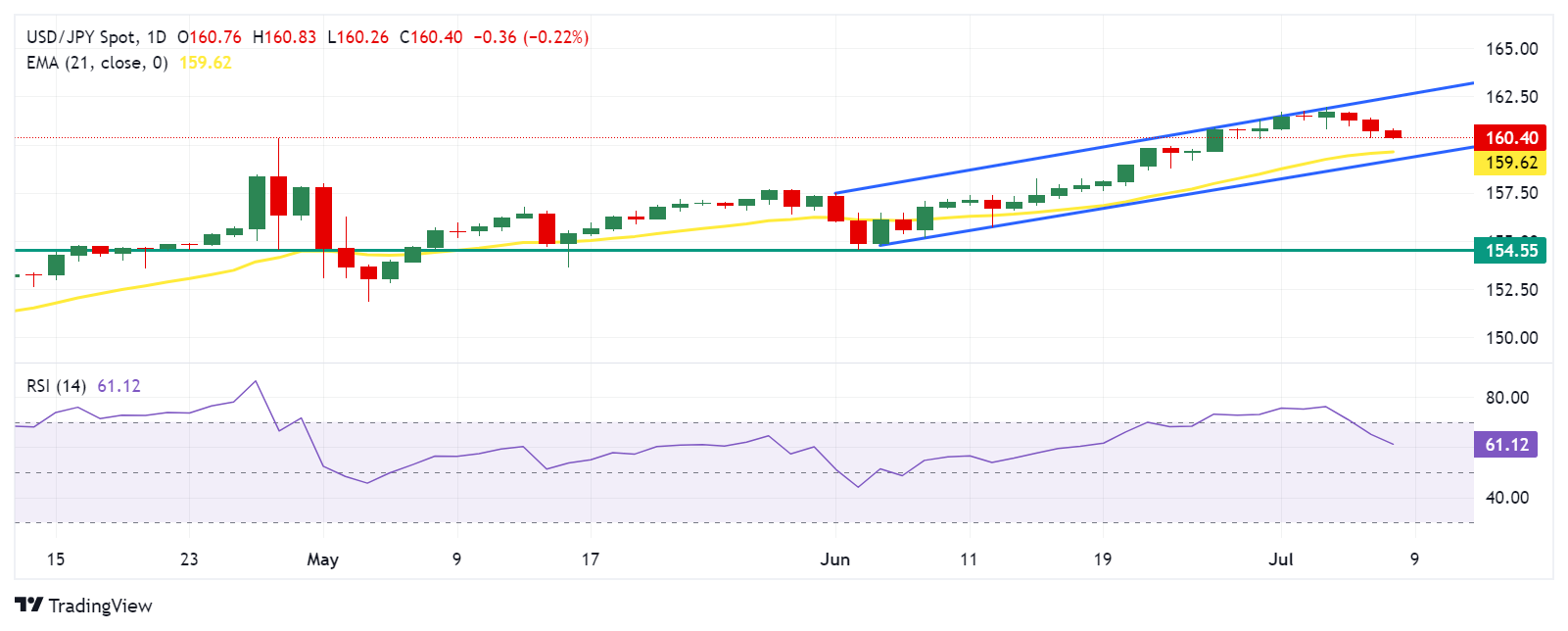- The Japanese Yen gained strength while the US Dollar faced challenges following the release of weaker-than-expected US job growth data on Friday.
- Japan’s current account surplus widened to ¥2,849.9 billion ($17.78 billion) in May, from ¥2,050.5 billion previously.
- Friday’s jobs data sparked speculation that the Fed could initiate rate cuts sooner.
The Japanese Yen (JPY) extends gains for a third straight session on Monday. The USD/JPY pair loses ground as the US Dollar (USD) struggles following the release of weaker-than-expected US job growth data on Friday.
Japan’s current account surplus extended its growth streak into the 15th month in May. The Finance Ministry reported on Monday that the current account rose to ¥2,849.9 billion ($17.78 billion) in May, up from ¥2,050.5 billion in the previous month, beating market expectations of ¥2,450.0 billion.
US Nonfarm Payrolls (NFP) beat market expectations in June, although the pace of growth was slower compared to May. Moreover, the unemployment rate also rose in June. These developments have sparked speculation among traders that the Federal Reserve (Fed) could potentially initiate interest rate cuts sooner rather than later.
According to CME’s FedWatch tool, rate markets are currently pricing in a 70.7% chance of a rate cut in September, up from 64.1% just a week earlier.
Daily Market Wrap: Japanese Yen gains on dovish Fed sentiment
- Japan’s cash earnings rose 1.9% year-on-year in May, marking an acceleration from the 1.6% increase in April and reaching the highest level since January. However, this growth rate fell short of market expectations, which had anticipated a 2.1% rise.
- US Nonfarm Payrolls (NFP) rose by 206,000 in June, following a rise of 218,000 in May. This figure exceeded the market expectation of 190,000.
- The US unemployment rate rose to 4.1% in June from 4.0% in May. Meanwhile, average hourly earnings declined to 3.9% year-over-year in June from the previous reading of 4.1%, in line with market expectations.
- OCBC strategists Frances Cheung and Christopher Wong note that persistent USD/JPY strength is raising expectations for intervention. However, there is speculation that policymakers may monitor to what extent they allow further depreciation before intervening.
- Federal Reserve Bank of Chicago President Austan Goolsbee said on BBC Radio on Wednesday that getting inflation back to 2% will take time and that more economic data is needed. However, on Tuesday, Fed Chair Jerome Powell said the central bank is returning to a disinflationary path, according to Reuters.
- Minutes from the Federal Reserve’s June 11-12 policy meeting, released Wednesday, suggested Fed officials were in wait-and-see mode. “Some participants emphasized the Committee’s data-dependent approach, with monetary policy decisions being conditional on economic developments rather than on a pre-set path.”
- Rabobank FX strategists noted on Wednesday that yield spreads appear crucial to the USD/JPY outlook. They suggested that intervention in the currency market could be imminent due to the weakness of the Japanese Yen, which is putting downward pressure on consumer confidence.
Technical Analysis: USD/JPY holds around 160.50
The USD/JPY is trading around 160.30 on Monday, showing a bullish bias based on the daily chart analysis. The pair remains within an ascending channel pattern. However, caution is advised as the 14-day Relative Strength Index (RSI) has dipped below 70, indicating a possible weakening of the ongoing uptrend.
In the near term, the USD/JPY could approach the resistance near 162.50, which marks the upper boundary of the ascending channel. A break above this level could strengthen the bullish sentiment, potentially leading the pair towards the psychological resistance at 163.00.
On the downside, immediate support is seen around the 21-day exponential moving average (EMA) at 159.62, followed by the lower boundary of the ascending channel around 159.00. A further drop below this channel support could see USD/JPY testing the vicinity of the June low at 154.55.
USD/JPY: Daily Chart
Japanese Yen PRICE Today
The table below shows the Japanese Yen (JPY) exchange rate against major currencies today. The Japanese Yen was the strongest currency against the Australian Dollar.
| USD | EUR | GBP | JPY | CAD | AUD | NZD | CHF | |
|---|---|---|---|---|---|---|---|---|
| USD | 0.10% | 0.03% | -0.21% | -0.06% | 0.02% | -0.14% | -0.09% | |
| EUR | -0.10% | 0.14% | 0.02% | 0.15% | 0.08% | 0.10% | 0.14% | |
| GBP | -0.03% | -0.14% | -0.16% | 0.04% | -0.06% | -0.04% | 0.00% | |
| JPY | 0.21% | -0.02% | 0.16% | 0.15% | 0.24% | 0.22% | 0.17% | |
| CAD | 0.06% | -0.15% | -0.04% | -0.15% | 0.04% | -0.08% | -0.02% | |
| AUD | -0.02% | -0.08% | 0.06% | -0.24% | -0.04% | 0.02% | 0.06% | |
| NZD | 0.14% | -0.10% | 0.04% | -0.22% | 0.08% | -0.02% | 0.05% | |
| CHF | 0.09% | -0.14% | -0.01% | -0.17% | 0.02% | -0.06% | -0.05% |
The heatmap shows percentage changes of major currencies. The base currency is selected from the left column, while the quote currency is selected from the top row. For example, if you choose the Japanese Yen from the left column and move along the horizontal line to the US Dollar, the percentage change shown in the chart will represent the JPY (base)/USD (quote).
Japanese Yen FAQs
The Japanese Yen (JPY) is one of the most traded currencies in the world. Its value is determined broadly by the performance of the Japanese economy, but more specifically by the policy of the Bank of Japan, the spread between Japanese and US bond yields, and risk sentiment among traders, among other factors.
One of the Bank of Japan’s mandates is currency control, so its moves are key to the Yen. The BoJ has intervened directly in currency markets on occasion, usually to lower the value of the Yen, although it often refrains from doing so due to political concerns of its major trading partners. The BoJ’s current ultra-loose monetary policy, based on massive stimulus to the economy, has caused the Yen to depreciate against its major currency peers. This process has been exacerbated more recently by a growing policy divergence between the BoJ and other major central banks, which have opted to sharply raise interest rates to combat decades-old levels of inflation.
The Bank of Japan’s stance of maintaining an ultra-loose monetary policy has led to an increase in policy divergence with other central banks, in particular with the US Federal Reserve. This favours the widening of the spread between US and Japanese 10-year bonds, which favours the Dollar against the Yen.
The Japanese Yen is often considered a safe haven investment. This means that in times of market stress, investors are more likely to put their money into the Japanese currency due to its perceived reliability and stability. In turbulent times, the Yen is likely to appreciate against other currencies that are considered riskier to invest in.
Source: Fx Street
I am Joshua Winder, a senior-level journalist and editor at World Stock Market. I specialize in covering news related to the stock market and economic trends. With more than 8 years of experience in this field, I have become an expert in financial reporting.








